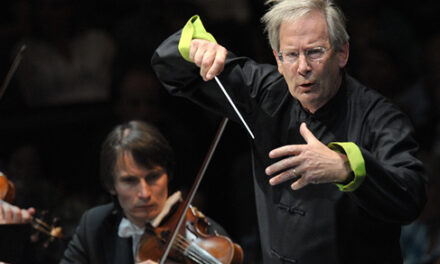KURPLOP! A collection bone, muscle, and sinew are stopped suddenly by the floor. Repetitiously one, two, three, four, five bodies locate standing only to propel back to the ground. Audible made its debut at American Dance Festival this weekend and began with five people being propelled individually onto stage by a unified force. This evening length work was filled with pedestrian movement and athleticism that transitioned through the body to reveal a unique combination of fluidity and speed. Over time, this combination transformed common gestures into a unique contemporary movement language.
Underneath stark white lights, five dancers occupied the stage space wearing suit jackets, button down shirts, and slacks in varying shades of black and grey. Their collective image felt young, professional, and metropolitan. They executed a range of movement — energetic, delicate, strong, and quick. This negotiated movement vocabulary entertained sustained conversations and interrupted frequencies.
The construction of Audible suggested a clear consideration to composition and flow. Entrances and exits kept the space alive and active. Stage lighting marked off designated areas and guided the spectators’ eye. The music was a combination of ambient, abstract soundscapes, and identifiable low frequency beats. The arch of the work appeared to manifest during a low, grounded sequence of choreography. The music was reminiscent of erratic heartbeats, and this sentiment was echoed in the ensemble’s movement.
Overall, the work offered suggestions of surveillance, voyeurism, and connection. During one humorous moment, a male performer became an unsuspecting subject of mimicry by his cast mates. Although he was never able to confirm his suspicion, a dramatic shift occurred when the ensemble began to predict his movement. The imitated transformed into the imitator. Ideas surrounding surveillance and voyeurism were further explored when houselights rose during the work to expose the audience. The power of surveillance shifted and the audience became the subject of mimicry through movement.
Audible also presented a recurring theme surrounding connection. A female and male dancer connected back to back to create a duet reminiscent of a reverse tango. Connecting and articulating undulating spines and torsos, we patiently watched as they tried to rediscover prescribed physical connection. A concentrated solo occurred in silence to reveal the connection between breath and movement. We could hear the soloist ignite breath into his muscles and transmit information into his joints to execute movement. During group sequences, movement in unison connected the dancers and traditionally crafted the stage space. In other moments, eyes and touch were used to bridge the space between bodies.
Acknowledging the presence and repercussions of technological use, Audible is timely and relevant. Although the effects of technology were brought to the forefront, this work interestingly addresses the effects of interactive technology without the inclusion of its physical devices. We are never offered a solution or conditions for reconciliation involving the saturation of technology in our culture. It appears that we are simply tasked to confront this reality. As we sift through the comfort of social media, smart phones, laptops, and digital reading devices, how might we address the replacement of human interaction with interactive technology? This question was echoed in the closing image of this work. One dancer remained suspended in movement downstage while her colleagues stood sprinkled around her. Her gaze is caught upward while the others stare blankly out into the audience space.
Combining urban and contemporary dance into a raw and energetic package the 605 Collective is a popular and inspiring dance group from Canada. This weekend marks their debut at American Dance Festival (ADF). Fueled by co-founders Lisa Gelley, Shay Kuebler, and Josh Martin, 605 Collective nurtures a collective choreographic voice and process. All performers participate in the creation, composition, and artistic provocation of the works.











